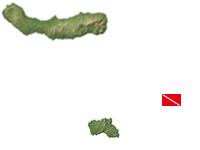Banco Dollabarat
Description
By boat
70 minutes from the Vila do Porto Harbour (Santa Maria), 120 min from the Vila Franca do Campo Harbour (São Miguel), 150 min from the Ponta Delgada Harbour (São Miguel)
Depth

Banco Dollabarat
The unique experience of diving in the Banco Dollabarat (Dollabarat Reef) begins during the 33-nautical-mile trip from the southeast tip of São Miguel, or the 20-mile trip from the island of Santa Maria. Its remote location means this dive site is one of the best of the Azores, but is only recommended for experienced divers as it is far from the mainland and is prone to strong currents.
The long boat-trip in itself a great adventure, with many divers spotting cetaceans, turtles and seabirds, particularly around the bank. You can start your dive at the bank, or take advantage of the proximity to the Formigas Islets and dive in both sites. Both are classified as marine reserves so fishing is prohibited.
On a calm day, once the boat is anchored you can see the shallowest part of the seamount (only 5 metres deep), with marine life ‘flying’ over the reef. You start diving in the shallowest area (5 metres deep) before moving to other deeper areas (8-10 metres) that quickly drop to 20-30 metres. It is here that you are best placed to observe both the abundant life along the seafloor and pelagic species swimming in the blue. You can expect to see large dusky groupers (Epinephelus marginatus), island groupers (Mycteroperca fusca) and barred hogfish (Pseudolepidaplois scrofa), as well as rarer species such as devil rays.
During this dive, you should pay attention to the water column and look out for the large pelagic species, including skipjack tunas (Katsuwonus pelamis), big-eye tunas (Thunnus obesus), wahoos (Acanthocybium solandri), large Atlantic bonitos (Sarda sarda), yellowmouth barracudas (Sphyraena viridensis), and white trevallies (Pseudocaranx dentex). A fortunate diver could be lucky enough to see sharks, including the mythical smooth hammerhead (Sphyrna zygaena) and the Galapagos shark (Carcharinus galapagensis), along with devil rays and even huge giant mantas (Manta birostris).


